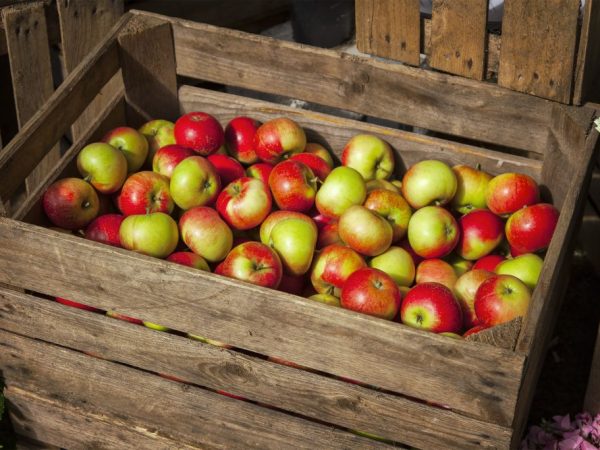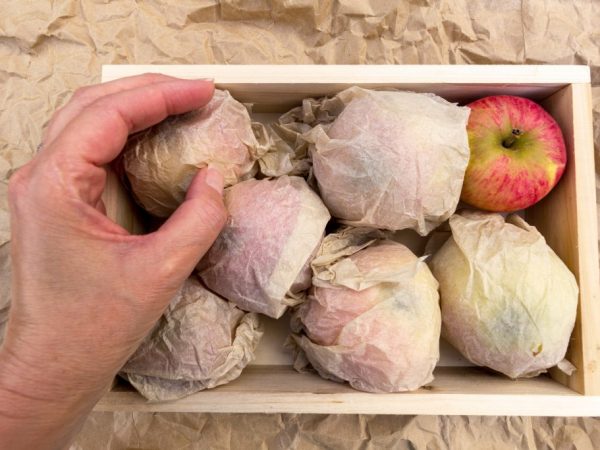Features of storing apples in winter
Everyone wants to keep delicious and beautiful homemade apples as long as possible. Of course, the fruits can be processed into jam or compote, but we like fresh fruits more. It is possible to store apples in a cellar or basement during the winter, but this requires proper preparation and placement.

Features of storing apples in winter
We collect and select fruits
Harvesting is carried out on a fine day without rain and high humidity. In this case, it is better to wear gloves so as not to erase the natural wax coating on the fruit.
The collection begins from the lower tiers of the branches, gradually moving towards the upper ones. The apple is carefully scrolled, after which the stalk is easily separated from the branch. It is better to put something soft in the basket for collecting fruits, and carefully lay out the fruits on top, being careful not to damage the skin.
The fruits that have fallen from the apple tree can also be harvested, after which the spoiled ones can be separated from the good ones.
Only whole and healthy apples are suitable for storage - without rot, scratches, specks and lined sides.
The main thing is that in no case should you wash or wipe the fruit. Without a natural protective shield, they will lie much less.
For the first week, you will have to keep a close eye on the collected fruits: remove specimens that looked good when selected, but soon began to deteriorate.
Storage preparation
Premises
Home conditions are not suitable for storing apples in winter - you need a cellar or basement with a temperature no higher than 5 ° C.
The optimum temperature for good preservation of apples of any kind is 2 ° C - 4 ° C. It is not scary if it drops by a few degrees, but it should not be lower than -1 ° С.
The humidity in the cellar or basement should be high, the optimal value is 90% (plus or minus 5%).
Insulating materials can be used to create the necessary conditions, and wet and dry sawdust can be used to adjust the moisture level.
It is better to whitewash the walls with lime, and treat the racks with a disinfectant. Consideration must also be given to ventilation, which will reduce the level of ethylene fumes.
Ethylene, which is released by fruits, makes the apples themselves and all neighboring products ripen faster.
Container
As a container, you can use the built-in basement racks, spreading shavings, paper, natural fabric, sawdust or sand on them. A good option would be plastic boxes with "holes" like store-bought ones.
At home, you can make wooden boxes similar to them. If none of this is available, the fruit can be folded into a basket or simply into a box made of thick cardboard.
If you want to preserve a particularly valuable variety, wrap each apple in paper (just do not use newspapers - printing ink is very harmful).
Styling

The fruits must be divided among themselves with paper
In order to properly store apples in the cellar, they are carefully laid in layers (from 1 to 3). You can't just heap them up. The layers must be separated from each other with cloth, paper or sawdust.
Apples are laid with the stalk up or slightly to the side.The essence of the method is as follows - the fruits should not scratch each other with the stalks. It should not be forgotten that access to fruits must remain free - they will have to be sorted often so that some of the spoiled apples do not spoil the neighbors.
Storage of seedlings
Apple seedlings, rootstocks and scions can also be stored in a cellar or basement during the winter at the specified temperature and humidity.
A seedling with an open root system can be stored in a container with peat, sawdust, sand. The roots are pre-moistened and then watered every week.
Gardening tips
- To keep apples fresh longer, some gardeners prefer to process them with propolis, wax, manganese, glycerin. Of course, such fruits must be thoroughly washed or peeled before use.
- Apples should not be placed next to potatoes, cabbage, onions or garlic. The ethylene released first will accelerate the ripening and germination of the latter, and besides, the apples will be saturated with the smell of vegetables. It is allowed to put them next to the pears in a separate compartment or separate them with a partition.
- It is better to wipe the container in which the fruits will be stored with soda ash.
- Since the temperature is higher at the top of the rack than at the bottom, the apples from the top shelves should be consumed first.
- Apples of different varieties must be stored in different containers.
- Before sprinkling the fruit with sand, it must be calcined. You can also use oak, maple or birch leaves for pouring. You should be more careful with the straw - make sure that rotting bacteria do not start in it.
- Apples can be kept fresh in plastic bags. The fruit is packaged and kept in the basement for a couple of hours to synchronize temperatures, and then tied tightly. In the early days, the fruits emit carbon dioxide, which then retains them for a long time.
- Some gardeners put a piece of cotton wool soaked in vinegar in a plastic bag of fruit to make the gas more intense.
- You can separate the apples from each other with the help of cardboard partitions, having built a kind of cells in the box.
- Fruit should be revised at least monthly in order to remove rotten specimens in time.
Typical mistakes
- Novice gardeners often try to preserve varieties with poor keeping quality that are not intended for long-term storage - usually these are early summer varieties.
- You should not get carried away with too late winter varieties - they, of course, will persist, but their skin will become too tough, and the flesh will become hard.
- If the level of humidity in the basement is low, the apples wither, wrinkle and do not store for a long time.
- Overfeeding an apple tree with fertilizers, we ourselves reduce the keeping quality of its fruits - apples from such a tree will not last long.
- Late picking of fruits is also a mistake - apples lose their taste and vitamin qualities, and become susceptible to diseases.
- Harvesting should not be done on rainy or damp days, as the remaining moisture causes rotting. Also, the collection cannot be carried out after night frosts.
Conclusion
In order for the apples to lie as long as possible, they must be properly collected and prepared for storage.
Of particular importance is the temperature regime and the level of humidity in the basement, as well as the correctly selected container and the way of laying the fruits.
Taking into account the advice of gardeners and common mistakes made by beginners, you will keep your harvest fresh and tasty without much effort.

